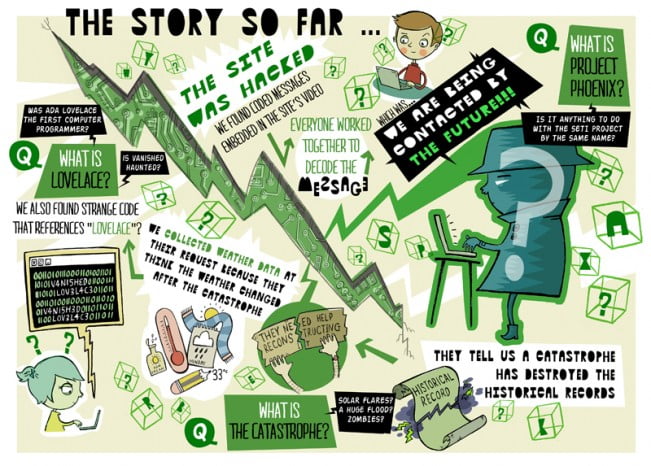
in alternative science education.
This month, thousands of middle-school students are going online to play an interactive video game. That might not sound surprising, by itself. But in this case, the game is a special science-mystery project, “Vanished,” created by MIT researchers on behalf of the Smithsonian Institution, as a novel experiment in alternative science education.
“Vanished” is a two-month-long game, which debuted the week of April 4 and stems from an initial scenario revealed in recent video messages on the site. The premise is that people living in the future have contacted us in the present, to answer a question: What event occurred between our time and theirs that led to the loss of civilization’s historical records? Students must decode clues in hidden messages, and in response find and provide information about Earth’s current condition, such as temperature and species data, to help people in the future deduce what wound up happening.
“Vanished,” the first game of its kind, is intended to take the problem-solving and critical-thinking skills kids often develop playing other forms of video games, and translate those habits into a scientific context; the goal is to help students experience science as an engaging process of mystery and discovery.
“Too often, kids are convinced science is no fun and not for them,” says Scot Osterweil, research director of MIT’s Education Arcade, a group jointly housed in MIT’s Comparative Media Studies program and the Scheller Teacher Education Program, which created the game. “They believe it’s all about rote memorization and procedure. But as game designers, we’re convinced that game playing is a lot like science: There is problem-solving, exploration, collaboration, hypothesizing, testing and learning from your failures.”
Informal learning
So far in April, more than 5,000 students have registered for “Vanished,” and approximately 4,000 messages are being posted daily on the site’s forums, where participants discuss clues and share information. Students can also hunt for clues at 17 Smithsonian-affiliated science museums nationally.
The game’s conceptual origins lie in discussions researchers in the Comparative Media Studies group have had with Smithsonian officials, dating back about four years. The creation of “Vanished” took place after the MIT researchers won a grant to develop the game from the National Science Foundation (NSF) in 2009.
The NSF has an interest in projects such as “Vanished” due in part to the agency’s findings, over many years of research surveys, that much of the public’s science knowledge comes from outside the classroom. The grant for developing the game came from the NSF’s program in “Informal Science Education,” which seeks new ways to interest students in science.
The MIT researchers hope that participating in “Vanished” will help break down myths among students, and help them realize that in asking questions and hunting for information, they are performing tasks central to science.
“Scientists aren’t a priesthood of people with secret knowledge,” Osterweil says. “They don’t walk around with it all in their heads. They do research to find it out.”
For that matter, a group of scientists will be participating in video chats with the students later this month, to listen to the students’ hypotheses and offer feedback. “I think it’s a great opportunity, because the students are not just learning content, but acting as practicing scientists,” says Elizabeth Cottrell, a geologist and director of the Smithsonian’s Global Volcanism Program. “The students are developing scientific habits of mind, not just memorizing vocabulary.”
It was also critical, Osterweil points out, to create a game in which students could not merely find the correct answers by looking them up online; rather, they must go out into their neighborhoods and actively record information. For this reason, the scenario played out in “Vanished” could not involve Earth’s past—about which answers can be googled—but only its present and future.
A model for future games
“Vanished” was produced by a team of researchers in Comparative Media Studies, including Osterweil, project manager Caitlin Feeley and even several students in MIT’s Undergraduate Research Opportunities Program (UROP). The MIT researchers hope to use the game as a model for the creation of future online science-education tools, and have created metrics to assess its performance.
“One thing I like about ‘Vanished’ is that there is a lot of assessment built in,” says Cottrell, who was not involved in creating the game, but says she will also be interested in evaluating how the students are responding to the game during her virtual discussion with them.
The ideal response a teacher can have when assessing an educational game is, according to Osterweil, “‘I’m seeing performance from kids I wasn’t expecting to see.'” In that sense, he adds, “We’re hoping teachers and parents see what their kids are capable of.”
Osterweil promises that “Vanished” will have some surprising plot twists for its participants as the month rolls on, though naturally he could not yet reveal what they were on the record. For that, students will have to sign up and play along.



